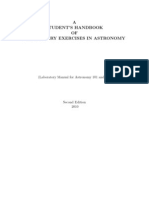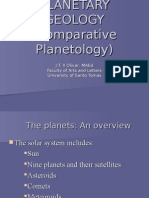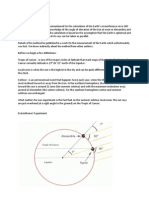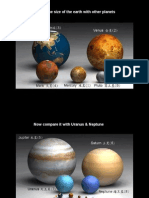0 ratings0% found this document useful (0 votes)
The HR Diagram
The HR Diagram
Uploaded by
Zhiyong HuangThe Hertzsprung-Russell Diagram shows the relationships between stars by plotting their brightness against their temperature. Most stars fall along the main sequence, which is a curved line sloping from the top left to lower right of the diagram, as there is usually a predictable relationship where hotter stars are brighter due to their larger surface area radiating more energy. The diagram divides stars into main sequence, red giant, supergiant, and white dwarf regions based on their luminosity and temperature.
Copyright:
© All Rights Reserved
Available Formats
Download as PPTX, PDF, TXT or read online from Scribd
Download as pptx, pdf, or txt
The HR Diagram
The HR Diagram
Uploaded by
Zhiyong Huang0 ratings0% found this document useful (0 votes)
The Hertzsprung-Russell Diagram shows the relationships between stars by plotting their brightness against their temperature. Most stars fall along the main sequence, which is a curved line sloping from the top left to lower right of the diagram, as there is usually a predictable relationship where hotter stars are brighter due to their larger surface area radiating more energy. The diagram divides stars into main sequence, red giant, supergiant, and white dwarf regions based on their luminosity and temperature.
Original Description:
The HR Diagram
Copyright
© © All Rights Reserved
Available Formats
PPTX, PDF, TXT or read online from Scribd
Share this document
Did you find this document useful?
Is this content inappropriate?
The Hertzsprung-Russell Diagram shows the relationships between stars by plotting their brightness against their temperature. Most stars fall along the main sequence, which is a curved line sloping from the top left to lower right of the diagram, as there is usually a predictable relationship where hotter stars are brighter due to their larger surface area radiating more energy. The diagram divides stars into main sequence, red giant, supergiant, and white dwarf regions based on their luminosity and temperature.
Copyright:
© All Rights Reserved
Available Formats
Download as PPTX, PDF, TXT or read online from Scribd
Download as pptx, pdf, or txt
0 ratings0% found this document useful (0 votes)
The HR Diagram
The HR Diagram
Uploaded by
Zhiyong HuangThe Hertzsprung-Russell Diagram shows the relationships between stars by plotting their brightness against their temperature. Most stars fall along the main sequence, which is a curved line sloping from the top left to lower right of the diagram, as there is usually a predictable relationship where hotter stars are brighter due to their larger surface area radiating more energy. The diagram divides stars into main sequence, red giant, supergiant, and white dwarf regions based on their luminosity and temperature.
Copyright:
© All Rights Reserved
Available Formats
Download as PPTX, PDF, TXT or read online from Scribd
Download as pptx, pdf, or txt
You are on page 1/ 5
The Hertzsprung-Russell Diagram
What is the HR Diagram?
• Tool that shows relationships and differences between stars.
• Relative measure of brightness & temperature.
• Shows stars of different ages/stages at the same time.
Types of Stars
• Stars that fit the
expected pattern –
cool and dim; hot
and bright – are
called main
sequence stars
– Most stars fall in the
region called main
sequence.
– Curved line sloping
from top left to lower
right of HR diagram.
Why is there a “main sequence”?
• Usually there is a predictable relationship
between brightness and temp.
Hotter things are brighter
Hotter temp = more energy is radiated.
Bigger stars are brighter.
Bigger surface area = more energy radiated.
Regions of Stars
• Main sequence: A thin band extending from the top left
of the diagram to the lower right. Dwarfs stars lie along
the main sequence.
• Red giant region: Located towards the upper right of the
diagram. Stars located here are about 10 times larger
than the Sun, and many time more luminous.
• Supergiants: A band extending across the top of the HR
diagram from blue to red. These are extremely large and
luminous stars.
• White dwarfs: A region in the lower left of the diagram.
These are faint, hot, very small stars.
You might also like
- New Horizons Shedding Light On Frontier WorldsNo ratings yetNew Horizons Shedding Light On Frontier Worlds2 pages
- A Short Guide To Referencing The StandardsNo ratings yetA Short Guide To Referencing The Standards3 pages
- Lifting Titan's Veil: Exploring The Giant Moon of SaturnNo ratings yetLifting Titan's Veil: Exploring The Giant Moon of Saturn22 pages
- Astronomy - August 2013 (40th Anniversary Issue) (Gnv64)No ratings yetAstronomy - August 2013 (40th Anniversary Issue) (Gnv64)83 pages
- The Sun & Stars: Morgan George, Samantha GiddingeNo ratings yetThe Sun & Stars: Morgan George, Samantha Giddinge18 pages
- Solar System - Wikipedia, The Free EncyclopediaNo ratings yetSolar System - Wikipedia, The Free Encyclopedia24 pages
- The Origin of Mass: Elementary Particles and Fundamental Symmetries 1st Edition John Iliopoulos All Chapter Instant Download100% (3)The Origin of Mass: Elementary Particles and Fundamental Symmetries 1st Edition John Iliopoulos All Chapter Instant Download62 pages
- Astronomy Assessment Solar System-Sun Moon EarthNo ratings yetAstronomy Assessment Solar System-Sun Moon Earth3 pages
- Galaxy Analysis and Identification Lab ProcedureNo ratings yetGalaxy Analysis and Identification Lab Procedure3 pages
- The Various Types of Galaxies: by Alec RodriguezNo ratings yetThe Various Types of Galaxies: by Alec Rodriguez6 pages
- Liba Chaia Taub - Ptolemy's Universe - The Natural Philosophical and Ethical Foundations of Ptolemy's Astronomy-Open CourtNo ratings yetLiba Chaia Taub - Ptolemy's Universe - The Natural Philosophical and Ethical Foundations of Ptolemy's Astronomy-Open Court210 pages
- Science Illustrated Australia - February 2017100% (2)Science Illustrated Australia - February 201784 pages
- Deep Space Chronicle A Chronology of Deep Space and Planetar100% (2)Deep Space Chronicle A Chronology of Deep Space and Planetar224 pages
- Compare The Size of The Earth With Other PlanetsNo ratings yetCompare The Size of The Earth With Other Planets16 pages
- Foundation Mathematics Course Oultine 2017No ratings yetFoundation Mathematics Course Oultine 20172 pages
- Victorian Teaching and Learning Model: (Please Select All That Apply)No ratings yetVictorian Teaching and Learning Model: (Please Select All That Apply)3 pages
- Year 10 Maths Test of Chapter 1 and Chapter 10No ratings yetYear 10 Maths Test of Chapter 1 and Chapter 103 pages
- Grade Six Music Theory - The Rules of HarmonyNo ratings yetGrade Six Music Theory - The Rules of Harmony7 pages
- The Goals of Differentiation: Carol Ann TomlinsonNo ratings yetThe Goals of Differentiation: Carol Ann Tomlinson6 pages
- Lifting Titan's Veil: Exploring The Giant Moon of SaturnLifting Titan's Veil: Exploring The Giant Moon of Saturn
- Astronomy - August 2013 (40th Anniversary Issue) (Gnv64)Astronomy - August 2013 (40th Anniversary Issue) (Gnv64)
- The Origin of Mass: Elementary Particles and Fundamental Symmetries 1st Edition John Iliopoulos All Chapter Instant DownloadThe Origin of Mass: Elementary Particles and Fundamental Symmetries 1st Edition John Iliopoulos All Chapter Instant Download
- Liba Chaia Taub - Ptolemy's Universe - The Natural Philosophical and Ethical Foundations of Ptolemy's Astronomy-Open CourtLiba Chaia Taub - Ptolemy's Universe - The Natural Philosophical and Ethical Foundations of Ptolemy's Astronomy-Open Court
- Deep Space Chronicle A Chronology of Deep Space and PlanetarDeep Space Chronicle A Chronology of Deep Space and Planetar
- Victorian Teaching and Learning Model: (Please Select All That Apply)Victorian Teaching and Learning Model: (Please Select All That Apply)

















































































